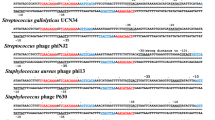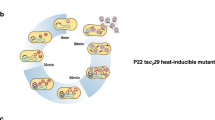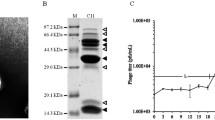Summary
The effects were studied of three clear plaque mutations of phage P22 (cir4-1, cir5-1 and cir6-1) on antirepressor synthesis. The mutant site cir4-1 has no influence on the expression of gene ant. The cir5-1 and cir6-1 mutations prevent the repression of early ant synthesis shortly after infection: P22 cir5-1 exhibits a strong ant-overproduction because it renders the cir5 repressor protein defective for turning off early ant expression (Harvey et al. 1981). P22 cir6-1 exhibits only a low level of constitutive ant synthesis insensitive to cir5-directed repression. Complementation experiments between P22 wild type or mutant in the cir5 or cir6 sites reveal the following phenotypes of the cir6-1 mutation: (1) The cir6-1 site behaves as a weak promotor site insensitive to cir5-directed repression of ant synthesis. (2) In the P22 cir5-1 cir6-1 double recombinant the cir6-1 site is cis dominant preventing ant overproduction as observed in simple P22 cir5-1 infections. (3) Some of the deficient phenotypes of P22 cir6-1 can be complemented by co-infecting P22 mutants carrying a cir6 + allele. These results are explained by the following model: The active cir5 repressor protein is a dimer (or oligomer) and the cir5-1 and cir6-1 mutations map in different domains influencing the repressing as well as the dimer forming activities of this protein. Which particular cir6-1 phenotype is observed depends on the experimental conditions employed, and on the promotor site (either p ANT or cir6-1) from which ant expression procedes. P22 cir5-1 antam19 in su -bacteria does not produce any traceable amount of ant amber protein fragments, and an antam19 allele in trans to ant + restrains synthesis of ant protein.
Similar content being viewed by others
References
Botstein D, Waddell CH, King J (1973) Mechanism of head assembly and DNA encapsulation in Salmonella phage P22. I. Genes, proteins, structures and DNA maturation. J Mol Biol 80:669–695
Botstein D, Lew KK, Jarvik V, Swanson CA Jr (1975) Role of antirepressor in the bipartite control of repression and immunity by bacteriophage P22. J Mol Biol 91: 439–462
Gough M (1968) Second locus of bacteriophage P22 necessary for the maintenance of lysogeny. J Virol 2:992–998
Harvey AM, Hava P, Oppenheim AB, Prell HH, Soska J (1981) Repression of ant synthesis early in the lytic cycle of phage P22. Mol Gen Genet 181:74–81
Harvey AM, Heil J, Prell HH (1979) Repressor synthesis in regulatory mutants of bacteriophage P22. Mol Gen Genet 167:337–339
Levine M (1972) Replication and lysogeny with phage P22 in Salmonella typhimurium. Curr Top Microbiol Immunol 58:135–156
Levine M, Truesdell S, Ramakrishnan T, Bronson MJ (1975) An antirepressor locus and its controlling elements. J Mol Biol 91:421–438
Prell HH (1970 a) Px, a hybrid between the serological unrelated and heteroimmune Salmonella bacteriophages P22 and Py. I. Some properties of Py and Px, genetic evidence for the hybrid nature of Px and phenotypic mixing between P22, Py and Px. Mol Gen Genet 108:167–183
Prell HH (1970 b) Px, a hybrid between the serological unrelated and heteroimmune Salmonella bacteriophages P22 and Py. II. Contribution of P22 genetic material to different Px variants. Mol Gen Genet 108:184–202
Prell HH (1973) Regulation of gene expression in Salmonella phage P22. I. Genetic experiments involving P22 and Px1. Mol Gen Genet 127:327–339
Prell HH (1977) The role of ant-product of Salmonella phage P22 in the process of transactivation of prophage Px1. Mol Gen Genet 156:61–69
Prell HH, Auer JM, Soska J (1983) Clear plaque mutation sites linked to the immI region of the Salmonella phage P22. Genet Res 42:267–283
Prell HH, Auer JM, Soska J, Hava P (1984) The immI region of Salmonella phage P22. 1. Characterization of the mutants P22 cir4-1, P22 cir5-1 and P22 cir6-1. Mol Gen Genet 198:105–109
Sauer RT, Krovatin W, DeAnda J, Youderian P, Susskind MM (1983) Primary structure of the immI immunity region of bacteriophage P22. J Mol Biol 168:699–713
Susskind MM (1980) A new gene of bacteriophage P22 which regulates synthesis of antirepressor. J Mol Biol 138:685–713
Susskind MM, Botstein D (1978) Molecular genetics of bacteriophage P22. Microbiol Rev 42:385–413
Susskind MM, Youderian P (1982) Transcription in vitro of the bacteriophage P22 antirepressor gene. J Mol Biol 154:427–447
Youderian P, Chadwick SJ, Susskind MM (1982) Autogenous regulation by the bacteriophage P22 arc gene product. J Mol Biol 154:449–464
Author information
Authors and Affiliations
Additional information
Communicated by H. Böhme
Rights and permissions
About this article
Cite this article
Prell, H.H., Auer, J. & Soška, J. The immI region of Salmonella phage P22. Molec Gen Genet 198, 110–115 (1984). https://doi.org/10.1007/BF00328709
Received:
Issue Date:
DOI: https://doi.org/10.1007/BF00328709




